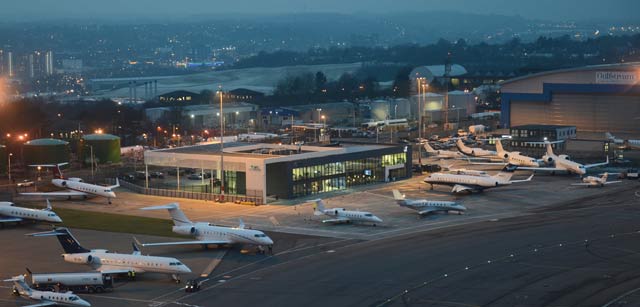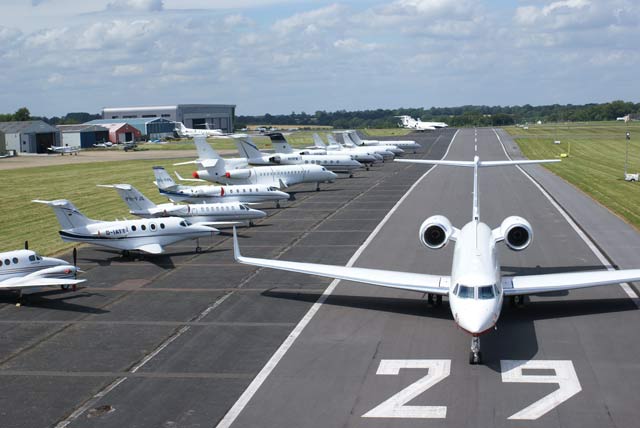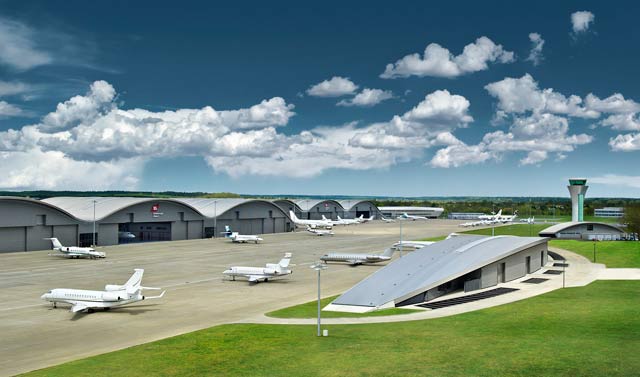No city in the world is better served for business aviation than London. Paris Le Bourget and Geneva are Europe’s busiest gateways for those travelling privately, but at least seven airports vie for business aviation traffic into the UK capital – and that does not include Heathrow and Gatwick. What is more, with several of these second tier and specialist airports investing heavily in improving their business aviation offering, competition is becoming even more lively.

Signature has invested £90 million in its FBO at Luton. Next hangar along is Gulfstream's MRO
Signature Flight Support
While London’s big two are almost entirely focused on airlines, the other three commercial airports – Luton, Stansted and City – have thriving business aviation operations. Luton may be most associated with leisure and low-cost carriers, but it also handles more private aviation than any other UK airport, while City’s unique selling point is its proximity to London’s financial centres as well as its West End – where hundreds of celebrities and wealthy foreigners have homes or go to shop.
Get all the coverage from EBACE here, 22-24 May
To the south-west, Farnborough – which styles itself the UK’s only dedicated business aviation airport – offers travellers and operators an upscale experience, with its stylish terminal, new hangars and luxury hotel. Biggin Hill, meanwhile, is home to several fixed base operations and dozens of based aircraft and offers rapid links to central London. So does RAF Northolt in west London, where London City Airport manages the executive terminal on behalf of the Ministry of Defence.
Further afield, Oxford airport in 2009 was restyled as London Oxford – despite being almost 100km from central London. However, the airport says it is popular with the business aviation community which values its motorway access to the wealthier neighbourhoods of west London as well as the science and high-tech industrial cluster around Oxford and Banbury. Meanwhile, east of London, Southend Airport has ambitious plans to grow its business aviation traffic tenfold by 2027.

Biggin Hill's growth forecasts are based on the increasing lack of space at hub airports
London Biggin Hill Airport
There are other smaller airports too. Blackbushe in Surrey – just 9km from Farnborough and base of Cessna Mustang air taxi operator Blink – promotes itself as being the most cost-effective airport for business jet users. Its simple terminal building contrasts with Farnborough’s opulent facilities and illustrates perhaps the sheer range of choices open to the business aviation community in terms of customer experience as well as location.
TAG-owned Farnborough certainly looks the part when it comes to projecting a business aviation-friendly image. With its white and chrome curved terminal and hangars, the airport has almost a James Bond glamour about it. “We are the only airport dedicated to business aviation. Every other one is a hybrid,” says chief executive Brandon O’Reilly, who asserts that the facility has been built and expanded over 15 years “with business aviation at our core”.
Movements in 2016 were “fairly stable” at around 25,000, but O’Reilly says that tells only half the story. During last year, the airport saw a 5.5% increase in airliner-size jets, with just over 1,000 flights. Moreover, although Farnborough has been constrained by locally-imposed traffic restrictions, from 2019 its limit has been raised substantially, to 48,000 this year and 50,000 by 2019, a move O’Reilly believes gives Farnborough plenty room for growth.
Also core to Farnborough’s appeal, he says, is its extensive hangar capacity – doubled from three to six bays ahead of the 2012 London Olympics. The hangars are full, with around 70% of the space taken up with based aircraft, and ad hoc stays accounting for the rest. A plush airport hotel – the Aviator, also owned by TAG – provides overnight facilities for crew and provides the home town of the Farnborough air show with a much-needed hospitality asset.
Farnborough’s biggest rival is Biggin Hill, closer to central London in the south-east suburbs and almost entirely devoted to business aviation, but with a very different business model to TAG. While the Swiss company owns most of the facilities at Farnborough, Biggin Hill owner Regional Airports acts more as a landlord, leasing space or facilities at the former RAF airfield to third-party tenants, while operating its own executive terminal.
Managing director Will Curtis says the airport’s blueprint is to offer a “triangle of complementary services” – a gateway to London, a base for local operators and a centre for maintenance, repair and overhaul. Biggin Hill is home to 14 MROs – the newest and most prestigious being Bombardier’s service centre. Since last year, Bombardier and FBO specialist Signature Flight Support have shared a showpiece hangar and fixed base operation, built by since-defunct Qatar company Rizon.

Substantial investment from owner TAG has given Farnborough a host of modern facilities
TAG Farnborough Airport
“We are unique in that we have land that we can develop,” says Curtis. “Our core strategy is to allow people to develop their business here – we can either give them land to build on or an existing facility.” Projects include new hangars, due to open later this year, and a “24/7-operating” four-star hotel aimed at crews, to be completed in 2019. A soon-to-be-selected “well-known name” catering company will be based on site to provide meals for both the hotel and aircraft operators.
Curtis says Biggin Hill’s other selling points are its operating hours – now 06:30 to 23:00 on weekdays – and, despite its lack of a motorway, rapid access to the capital. “The perception is that we don’t have a clear and easy route into London by car, but there are five or six ways and it rarely takes more than an hour to the West End. In addition, a helicopter service, operated by Castle Air, flies more than 1,000 times a year to Battersea helipad. “You can even order it on approach,” says Curtis.
Biggin Hill handles 15,000 business aviation flights a year, and is eyeing 25,000 by 2030. “But it’s not just about traffic,” he says. “It’s about attracting manufacturers and base aircraft, and getting more revenue from each movement.” The “saturation” of London’s hubs will push business aviation to specialist airports like Biggin Hill, he says. “In the 1990s, business aviation was forced from Heathrow and Gatwick, and the same thing is happening at Luton and Stansted. We are responding to that.”
It is an assertion Neil Thompson might argue with. The operations director of Luton, London’s busiest business aviation airport with around 30,000 flights last year, suggests that Signature’s £90 million ($117 million) investment last December in a FBO is evidence of the airport’s long-term commitment to business aviation. Signature – an established Luton tenant – competes at the airport with Harrods Aviation. Gulfstream also has its UK MRO base there.
Thompson maintains that business aviation can co-exist with passenger airlines at a growing Luton. “They complement each other. They have completely separate [terminal] facilities and they tend to operate at different times,” he says. Business aircraft parking space is being “maximised”, he adds. “Most business aviation wants to get into and out of London easily. That, our facilities and our 24h availability are our USPs. We suffer less than some of the others from restrictions.”
London City also insists business aviation can prosper alongside a busy commercial operation at the only airport in the centre of the capital. “You get less [airline] activity during the day which fits in very well with business aviation traffic,” says Nick Rose, its director of business aviation. Movements at the docklands airport “roll between” 5,000 and 10,000 a year, and the airport – which operates its own small executive terminal – “very much has business aviation in its forward plan”, says Rose.
Rose admits that one downside of London City for business aviation is that there are no base aircraft facilities, although there is room to park for the day. However, he dispels another criticism – that London’s City’s challenging approach makes it impossible for many aircraft to operate there. While some larger jets are unable to use the airport, “70% of aircraft types” can, says Rose, and many manufacturers invest heavily in making their models London City compliant.
Dassault – which has just had its largest model, the Falcon 8X, approved for London City – “has always supported the airport”, says Rose. So too has Bombardier. “When NetJets moved from Gulfstream to Bombardier, one of the conditions was that [the new Global aircraft] could do London City,” he says. Gulfstream too has approval for the G280 and plans to push through its G650, G600 and G500.
In 2016, London City won a five-year extension to its contract to run the VIP terminal at RAF Northolt, base for UK head-of-state and government flights. Although the airport is restricted to 12,000 movements a year and operating at capacity, the 1,684m runway offers a “capability that you don’t get at London City”, admits Rose. The location – a 50min drive from Mayfair and Kensington – and the fact that it is “the Queen’s airport” give it an “air of exclusivity” for some VIPs, he says.
Oxford Airport may not enjoy the same proximity to the capital, but says its “cost base and infrastructure” make it attractive to operators who want to base aircraft there. It hosts some 65 aircraft and says new EASA rules allowing single engine turboprops to be used for charter could lure new businesses. Tenants range from big names such as Gama Aviation and Airbus Helicopters to smaller charter, flight management and training outfits.
The airport handled more than 5,600 flights in 2016 (excluding piston-engine aircraft), up 6.4% on the previous year, and, as with some other airports covering the London market, is seeing larger jets make up a larger proportion of its traffic. It says its FBO has catered for a 46% rise in movements from jets heavier than 40t over the past two years. The airport is also investing in new buildings with its latest, 1,500m2 hangar due to open by the end of the year.
Southend airport – to the east of London – handles only 1,000 business aviation flights a year, about 1% of the London market, but the Stobart Group-owned facility has a 10-year ambition to increase this to 10,000. The reason for its confidence, says chief executive Glyn Jones, is that demand for business aviation access to London will continue to grow, but capacity is becoming more limited at many of its competitors, either through lack of ramp space or air traffic control congestion.
“Here we have no constraints in terms of apron space or our FBO,” says Jones. The airport is building more ramp space for business aircraft and intends to replace the original passenger terminal, which serves as its executive facility, with a new FBO. The airport is open 24h, has its own rail station and helicopter service, and is 45min drive from the City, says Rose. Southend will present its plans to “make a much bigger mark on business aviation in London” when it makes its EBACE debut.
Get all the coverage from EBACE here, 22-24 May
Source: Flight Daily News
















